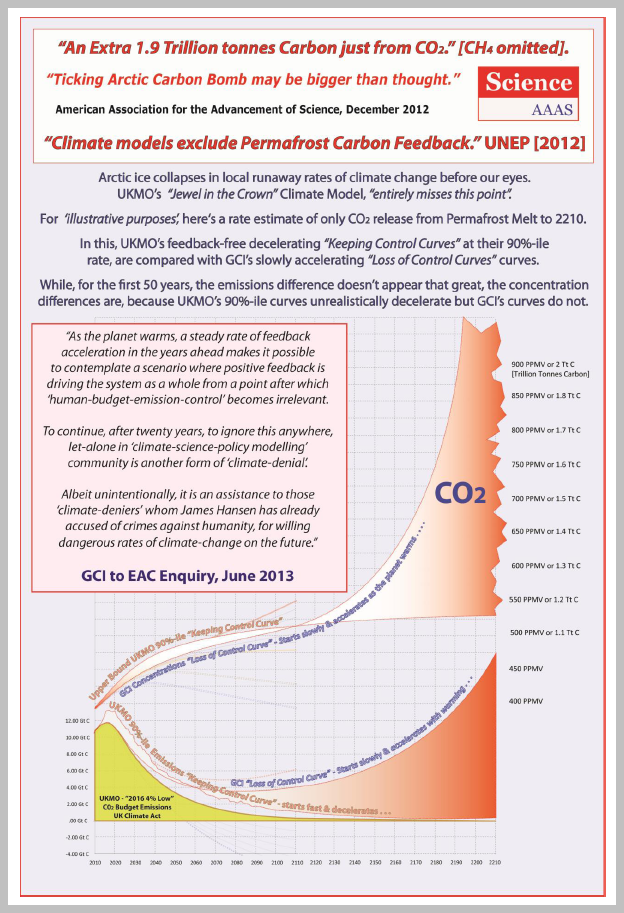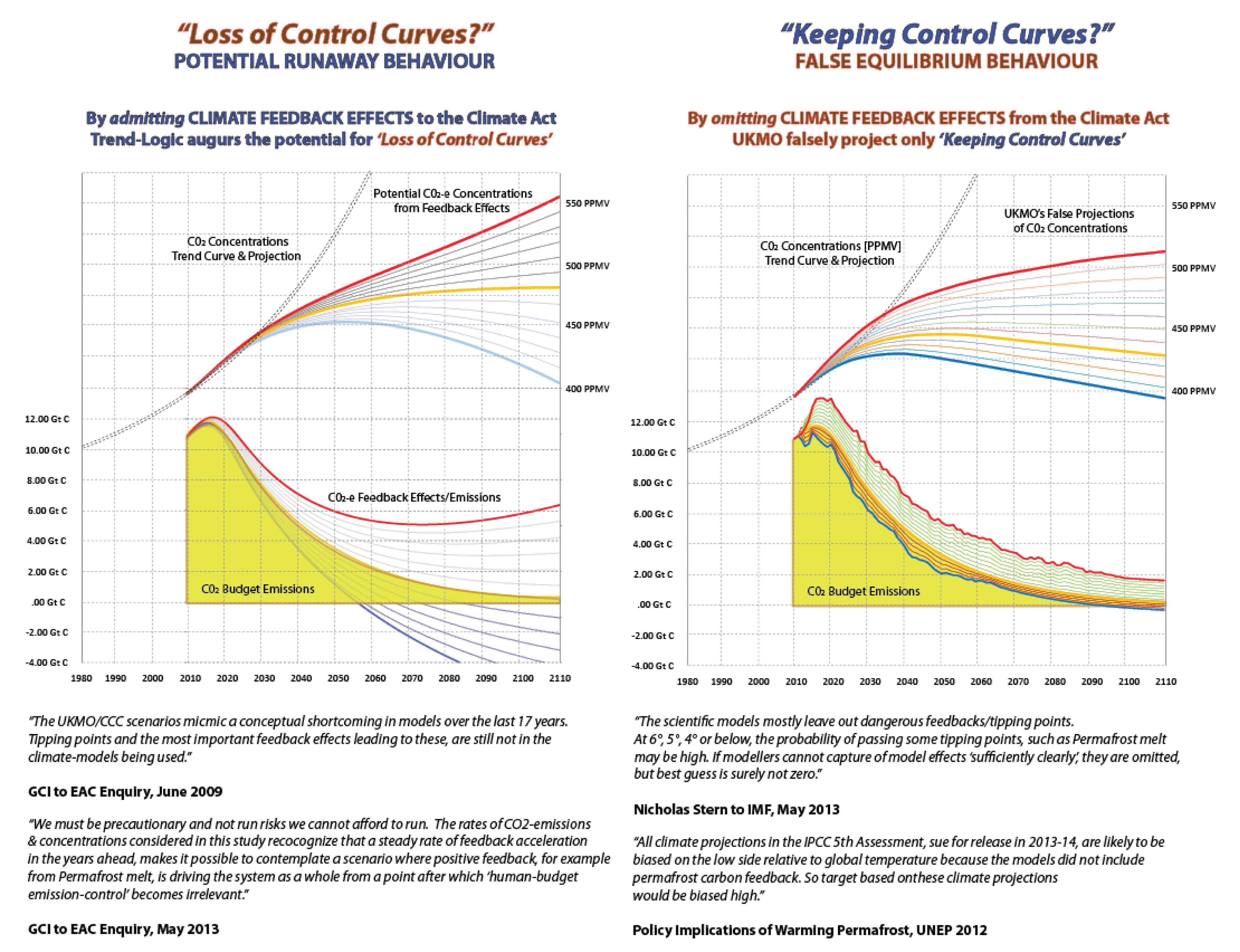C&C the UK Climate Act & the EAC Carbon Budget Enquiries (2009 to 2013)
Click logo to return to 'links-page'
The 1st EAC Carbon Budget EnquiryIn 2009, GCI submitted evidence to the first 'Carbon Budget Enquiry' of the UK House of Commons Environmental Audit Committee (EAC) setting out why the UK Climate Act was based on, 'the right principle but applied at the wrong rates'; UKMO rates of C&C gave worse than 50:50 odds for 2°C, while faster rates of C&C from GCI gave better odds: -
- contraction to zero emissions by 2100 for a less than 50% chance of limiting temperature rise to 2° C, while omitting to allow for feedback effects, the UK Met Office modelling of the source:sink function was unrealistically 'optimistic' and seriously misleading by end-loading the risks (this should be a faster lighter contraction-event);
- convergence to equal per capita emissions entitlements prescribed globally by 2050, by when 80% of the remaining carbon budget had been used up, the model was presented in a prescriptive and inequitable way, especially in the light of the UK's high share in the history of CO2 emissions from fossil fuel burning (convergence should be faster e.g. by 2030).
Notwithstanding, through the Copenhagen Climate Change Committee, in 2009 the UK Government insisted on advocating this prescription at COP-15, and this was met with strong refusal from Developing Countries. It was clear the UK Government did not politically grasp the full reality of sharing a limited and shrinking global carbon budget.
At that time, the UKMO agreed with GCI's definition of 'Sink-Efficiency'. However, they subsequently pushed back strongly against criticsm of their carbon contraction:concentration scenario in the UK Climate Act ('2016 3% Low'). This centred on the issue of 'omitted feedbacks' and was the source of what would become (and still is) a wider and substantial disagreement.
To replace the SRES emissions scenarios used in IPCC since 1994, in 2010, the UKMO gathered the 'new' feedback-free 'Representative Concentration Pathways' (RCP) scenarios to 'lead' preparations for IPCC AR5. The lowest carbon budget was in the RCP 2.6 scenario, similar to the UKCA. The highest (RCP 8.5) equalled levels at the Permian Extinction!For reasons unexplained to this day, the RCP scenarios for 1.5° C were removed at this time. Though UKMO deny all knowledge of this, these scenarios finally re-surfaced in IPCC AR5, but only in 2016 (in this rather under-emphasized table) suggesting even if they weren't used during IPCC AR5 preparations, they must have existed and been calculated before 2010.
GCI started work on the Carbon Budget Accounting Tool (CBAT). Primarily to project a precautionary approach to risk management, the heuristic modelling of feedback-emissions/effects in the CBAT animation was also to countervail the UKMO's climate feedback-free projections of the predominantly fossil fuel driven RCP methodology.
The 2nd EAC Carbon Budget Enquiry
In 2013, the first version of CBAT was presented in evidence to the second EAC Enquiry in 2013. This demonstrated why the dangers obscured by the feedback-free RCP methodology were an issue of grave concern. The UKMO denied these omissions, despite admitting these omissions on their own website in 2010 (see here pp 12 & 13).
The climate model used by the UKMO to generate the UK Climate Act was obviously inadequate. Nothing showed this more clearly than the complete omission of the melting Arctic region. The potential for climate change rates to accelerate out of control (runaway) had been completely ignored. NB in In December 2017, Jeremy Mathis, Director of NOAA's Arctic Programme has just said, "the environment is changing so quickly . . . there is an almost runaway effect . . . we can't quite get a handle on what this new state is going to look like."

As the original RCP spreadsheets show, the UKMO's feedback-free climate model behind the UK Climate Act, was monotonically iterated into all the RCP scenarios, from smallest to the largest. GCI rebutted the inadequate arguments made by the UKMO to the EAC in the House of Commons Enquiry, seeking to obfuscate this.GCI introduced the 'Carbon Budget Analysis Tool' (CBAT). This offered a more transparent and inclusive methodology to cognitively map this intractably difficult area of uncertainty & 'risk-calculation'. Comparison was made between the obfuscating 'Keeping Control' curves from the UKMO and CBAT's potential 'Loss of Control' curves.
GCI's submission to EAC was headlined thus: -.“As the planet warms, a steady rate of feedback acceleration in the years ahead makes it possible to contemplate a scenario where positive feedback is driving the system as a whole from a point after which ‘human-budget-emission-control’ becomes irrelevant. To continue, after twenty years, to ignore this anywhere, let-alone in ‘climate-science-policy modelling’ community is another form of ‘climate-denial’. Doing this unintentionally provides assistance to ‘climate-deniers’ against whom James Hansen has already and rightly levelled the charge of crimes against humanity for willing dangerous rates of climate-change upon the future. For UNFCCC-compliance, the struggle is now between control & a loss of control. To deal with this we need a new approach that will be precautionary, prevention-based and strategically goal-focused. It will distinguish between ‘budget-emissions’ which we can control and ‘feedback emissions’ and effects which we can’t. The approach will quantify as best we can, the runaway potential of rates of change that result from ‘Rapidly Inter Acting Feedback Effects’ [RIAFE] and the dangers of doing too little too late.”
Considering the huge rising risks and costs involved in getting this wrong, CBAT embedded a basis for precautionary policy-making & risk-averse decision-taking.
It is based on exploring the rates of rising risks of what we do know, but also what we don't or where we don't know with meaningful accuracy the future inter-active change rates of the: -
- carbon contraction of human budget emissions (this is a 'sociological' strategy/policy matter;
if it ever was, it is no longer a 'sceptical climate-science' matter)- weakening of the sink-function shows 'constancy' of the airborne-fraction of emissions starts changing
- further rise of heat-trapping carbon concentrations and water vapour in the global atmosphere
- further consequential rise of global temperature and consequently
- sea level rise
- ocean warming and acidfication
- ice and permafrost melt with increases in negative albedo causing
- secondary (non-budget) emission releases from non-fossil sources
- increasing stress on biological and ecological buffer systems
- showing the value of 'climate sensitivity' (dT = λ*dF) is not 'constant' but is inexorably revealed as the temperature-response to temperature-rise itself.
. . . . the net result of which will be the interactive compounding effect on overal warming from the above 'knowns', plus what inevitably are further 'unknowns'. The structure of the user-choice arrays in CBAT is here. In other words CBAT is a methodology for the cognitive mapping of known and unknown-unknowns.
Together, the potential of these feedback dynamics represent an existential threat. So it is vital to remember there is an unpayable cost for any underestimates of the rates of change projected in the 'scientific community's conservative models', resulting in 'too little emissions control too late' from the policy community and wider society.For whatever reason, simply ignoring the full potential spread of rapid interactive feedback dynamics, so falsely implying that we 'know' all this when we so obviously don't, is at the very least profoundly irresponsible.
To justify the amount of public money that has been invested in UKMO & their climate models, we need something more precautionary-policy-relevant & useful than 'complacently voyeuristic' come-what-may 100-year weather forecasts that under-estimate the risks & realities of the rates of global temperature rise and the increasingly catastrophic climate-damage rates we face.
The justification for doing this is already apparent in that rates of change are already accelerating faster than rates predicted by the climate models. The context in which this acceleration is occuring is embedded within the user-interactive CBAT cognitive mapping dynamics.
UKMO's subsequent response was to assert that CBAT had 'an error' in it & requested the coding to 'prove this'. The coding was provided. However, since then, the UKMO have been unable to prove anything and have remained unwilling or even unable to say what in fact 'the error' actually is.
In 2014 the final version of the CBAT 'user-chooser' animation was published online.
It was very well received by many experts.Former Government's chief scientist Sir David King called it "a beautiful piece of work" & used it to persuade John Schellnhuber (Director of Potsdam Climate Impacts) et al to abandon the RCP 2.6 scenario of 288 Gt C under-pinning the UKCA & adopt the carbon weight/rate equivalent of the Carbon Budgets as published in NATURE in June 2017 instead.
